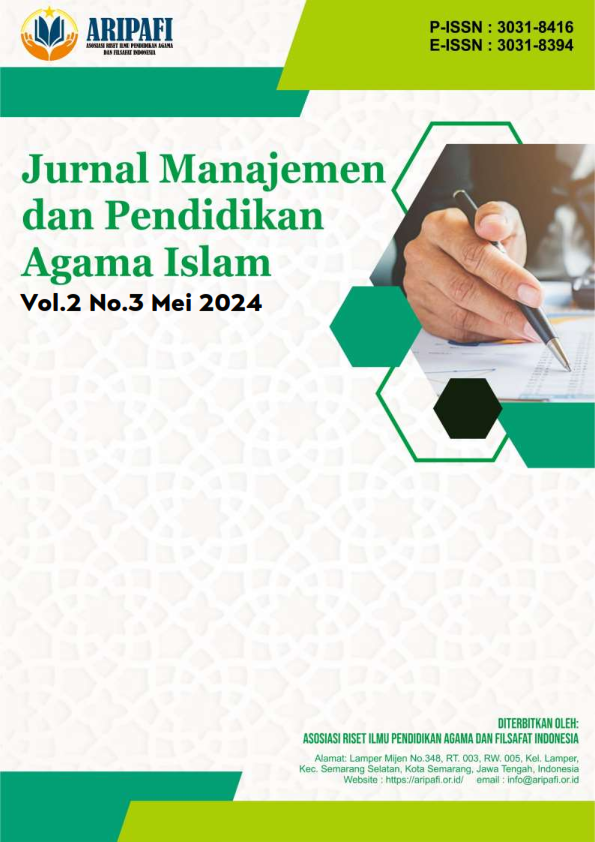Turuk Bintul Gastronomy in the Dimension of Islamic Education
DOI:
https://doi.org/10.61132/jmpai.v2i3.324Keywords:
Gastronomy, Turuk Bintul, Islamic EducationAbstract
The purpose of this study is focused on answering the social problems of turuk bintul gastronomy in the dimension of Islamic education. A qualitative approach in the setting of library research is used to answer these problems. The results showed that etymologically the name turuk bintul looks dirty, meaning female genitals with lumps. However, the purpose of this name is not to emphasize this aspect, but rather to focus on delicious and savory foods. The dimension of Islamic education is the importance of thinking clearly in responding to everything around us. In Islam, the term clear-minded is synonymous with husnuzon, which means to think clearly and think well about things or other parties. By responding in this way, the effect of this action will be good as well. This research hopes to contribute to Islamic education related to positive thinking.
Downloads
References
Ageeva, G. M. (2023). Media analysis in library research. Scientific and Technical Library, 5, 58–76. https://doi.org/10.33186/1027-3689-2023-5-58-76
Aji, R. P. (2014). Morpho-Semantic Analysis of Traditional Snack Names Correlated with Body Properties and Parts in the Special Region of Yogyakarta. Thesis : Universitas Gadjah Mada.
Anchori, D. (2017). Learn from Traditional Javanese Food. Jakarta : Language Development and Development Agency, Ministry of Education and Culture.
Annisa, D., &; Saputra, I. Y. (2023). Get to know Turuk Bintol, Jepara's Specialty Food with a Unique Name. Solopos.Com. https://jateng.solopos.com/
Asti, B. M. (2023, April 4). Turuk Bintul, Central Javanese Old School Confectionery. Telusuri.Id. https://telusuri.id/
Bhangu, S., Provost, F., &; Caduff, C. (2023). Introduction to qualitative research methods - Part 1. Perspectives in Clinical Research, 14(1), 39–42. https://doi.org/10.4103/picr.picr_253_22
Cuffia, F., Rojas-Rivas, E., Urbine, A., &; Zaragoza-Alonso, J. (2023). Use the free listing technique to learn consumer representation of traditional gastronomy in Argentina. Journal of Ethnic Food, 10(1), 1–13. https://doi.org/10.1186/s42779-023-00166-7
Dejournalist. (2022, March 3). Turuk Bintul, a Strange Snack from Jepara But Savory in Taste. Dejurnalis.Com. https://www.dejurnalis.com/
El Sham, R. S., &; Suwondo, A. (2023). Growth mindset accentuation in assisting the application of positive discipline for ustadz / ustadzah in Islamic boarding schools in Central Java. UNSIQ Journal of Research and Community Service, 10(1), 24–32. https://doi.org/10.32699/ppkm.v10i1.3377
Esparza Huamanchumo, R. M., Hernández-Rojas, R.D., Longa-López, R. A., &; Cárdenas-Jarama, M. (2023). Gastronomy as the effect of visitor loyalty: the case of Peru (Lima). International Journal of City Tourism, 9(2), 362–376. https://doi.org/10.1108/IJTC-03-2022-0071
Fuad, A. D., &; Hapsari, Y. T. (2020). Lexicon of Traditional Food in Javanese Language as a Reflection of Local Wisdom of Javanese People. Journal of Language and Literature Education, 19(1), 27–36. https://doi.org/10.17509/bs_jpbsp.v19i1.20756
García-Henche, B., &; Cuesta-Valiño, P. (2022). Increased visibility of women in gastronomy. International Journal of Gastronomy and Food Science, 30, 100589. https://doi.org/10.1016/j.ijgfs.2022.100589
Gempurnews. (2022, February 22). Turuk Bintul, a typical Jepara snack with a savory taste. Gempurnews.Com. https://www.gempurnews.com/
Gillespie, C., & Cousins, J. (2011). European gastronomy is entering the 21st century. London : Routledge.
Haikal, A., Wijanarko, H., Oktafia, O., Husnuzon, M. H., Gunawan, G., &; Arif, H. (2023). Securing Databases: A Comparative Study on the Impact of SSL Implementation on MySQL 8.0.33. Jartel Journal Telecommunication Network Journal, 13(2), 135–141. https://doi.org/10.33795/jartel.v13i2.735
Kaarsted, T., Blake, O., Nielsen, K. H., Alving, B., Rasmussen, L. T., Overgaard, A. K., &; Hansen, S. M. B. (2023). How European Research Libraries Can Support Citizen-Enhanced Open Science. Open Information Science, 7(1), 1–18. https://doi.org/10.1515/opis-2022-0146
Koerich, G. H., &; Müller, S.G. (2022). Knowledge of gastronomy in the context of socio-cultural transformation. International Journal of Gastronomy and Food Science, 29, 100581. https://doi.org/10.1016/j.ijgfs.2022.100581
Lantzy, T. (2022). Unvolunteer Online Students and Libraries: How Pandemic Closures Affected Student Library Research. Journal of Library and Information Services in Distance Learning, 16(3–4), 244–262. https://doi.org/10.1080/1533290X.2022.2149662
Linnaja, N., El Sham, R. S., &; Fuadi, S. I. (2023). Brand Storytelling Through a Morpho-Semantic Approach to the Syawalan Kupat Jembut Tradition in Pedurungan Semarang. Journal of Linguistic Research Families, 2(1), 165–181. https://doi.org/10.55606/jurribah.v2i1.1179
Murali. (2022). Integration of Religious Science and General Science. Book Chapter Proceedings of the Journey-Liaison of Academics and Society, 1(1), 367–375. https://j-las.lemkomindo.org/index.php/BCoPJ-LAS/article/view/38
Sabandar, S. (2022). 10 Javanese Culinary with a Dirty Name that is "Ngeres." Liputan6.Com. https://www.liputan6.com/regional/
Sakir, M., El Sham, R. S., &; Fuadi, S. I. (2023). Taboo Language Acronym BH Islamic Education Perspective. Journal of Research of Religious and Philosophical Clusters, 2(1), 167–178. https://doi.org/10.55606/jurrafi.v2i1.1232
Setyawanti, O., &; Andayani, S. (2015). Hygiene and sanitation of market snacks at Kotagede Market Yogyakarta. Family Journal, 1(2), 130–137.
Sugiyanto, B., El Syam, R. S., &; Fuadi, S. I. (2023). The essence of meaning behind Cawet: A toponymic study of hamlet naming in Surengede Wonosobo village. Journal of Social Research in Humanities and Educational Sciences, 2(2), 89–101. https://doi.org/10.58192/sidu.v2i2.792
Tabroni, I., Herawati , N. N., Pitriawan , W., &; Amin , S. (2022). Islamic Education in the Challenges of the Globalization Era. Journal of Education and Culture, 2(3), 38–41. https://doi.org/10.58707/jec.v2i3.143
detikJateng Team. (2022, February 20). Dirty Name 12 Culinary: Ketong Dick, Jembut Kecabut to Turuk Bintul. DetikJateng. https://www.detik.com/jateng/
Utoro Aji, D. (2021). Turuk Bintul, Jepara snacks whose name is dirty but tastes savory. DetikFood. https://food.detik.com/
Wardhana, Y. W. (2023). Turuk Bintul is a typical snack carving area. SOCLyfe.Com. https://www.soclyfe.com/
Wates. (2017). Turuk Bintul Khas Desa Wates. Wates Village, Simo District, Boyolali Regency, Central Java Province. https://wates.desa.id/
Widodo, A. (2023). Get to know Turuk Bintul, a typical Jepara snack with a dirty name. Inibaru.Id. https://inibaru.id/kulinary/
Wiyono, T. (2020, March 27). "Turuk Bintul", a typical Jepara food sensation. Kompasiana.Com. https://www.kompasiana.com/teguhwiyono/
Downloads
Published
How to Cite
Issue
Section
License
Copyright (c) 2024 Jurnal Manajemen dan Pendidikan Agama Islam

This work is licensed under a Creative Commons Attribution-ShareAlike 4.0 International License.





